Drone solutions offer innovative approaches to industrial asset management. You'll benefit from aerial inspection techniques that access hard-to-reach areas, providing detailed visual data. Thermal imaging detects heat anomalies, while LiDAR creates precise 3D models. These technologies enhance structural integrity assessments and streamline data processing. You'll see cost reductions through preventive maintenance strategies and improved safety measures. Drones assist with regulatory compliance, minimize environmental impact, and support efficient asset lifecycle management. As drone technology advances, you can expect even more capabilities in industrial applications. Exploring these solutions further will reveal their full potential for your asset management needs.
Key Takeaways
- Drones perform aerial inspections of hard-to-reach areas, providing detailed visual data and reducing downtime.
- Thermal imaging drones detect temperature anomalies, identifying potential equipment failures and enhancing predictive maintenance.
- Drones conduct structural integrity assessments, capturing high-resolution images of defects and prioritizing maintenance tasks.
- Advanced software processes drone-collected data, using AI and machine learning to generate actionable insights.
- Drones enhance safety by accessing hazardous areas, detecting potential issues, and providing real-time monitoring capabilities.
Aerial Inspection Techniques
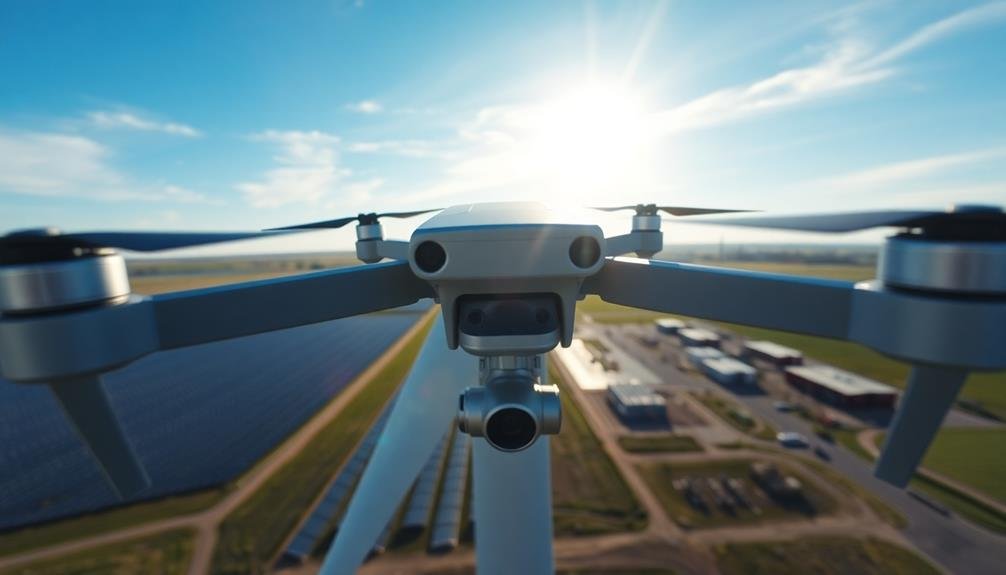
Aerial inspection techniques have revolutionized industrial asset management. You'll find that drones equipped with high-resolution cameras and sensors can access hard-to-reach areas of industrial structures, providing detailed visual data without putting human inspectors at risk.
These unmanned aerial vehicles (UAVs) can capture images and videos from various angles, offering an extensive view of assets like pipelines, power lines, and wind turbines.
You can use thermal imaging cameras mounted on drones to detect heat anomalies, identifying potential equipment failures before they occur. LiDAR sensors on drones create precise 3D models of industrial sites, helping you plan maintenance and upgrades more effectively.
For large-scale inspections, you'll appreciate how drones can cover vast areas quickly, reducing downtime and increasing operational efficiency.
When you're dealing with hazardous environments, such as chemical plants or offshore platforms, drones allow you to conduct inspections without exposing personnel to dangerous conditions.
You'll also find that the data collected by drones can be easily integrated into your existing asset management systems, providing a thorough digital record of your infrastructure's condition over time.
Thermal Imaging Applications
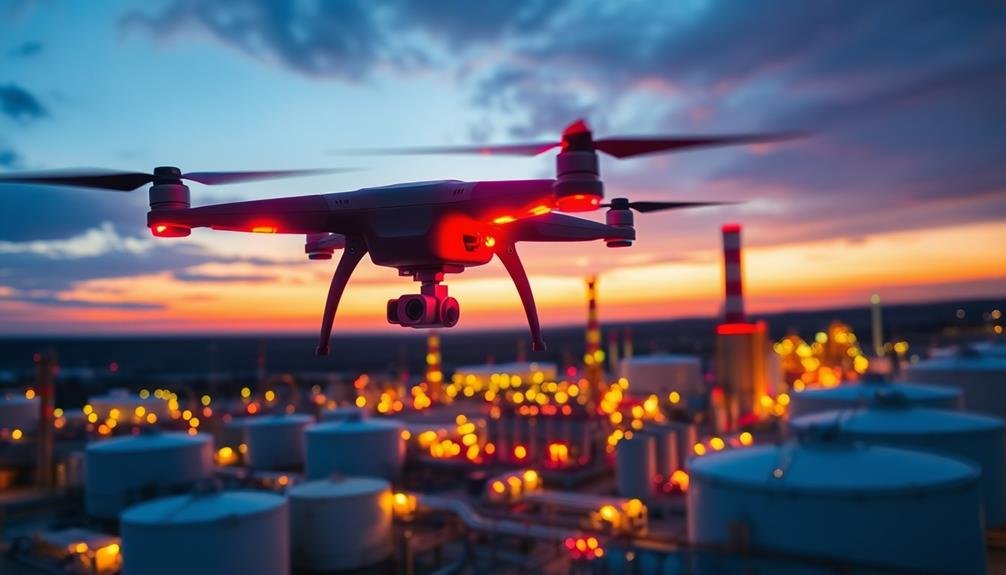
Harnessing the power of infrared technology, thermal imaging applications have become indispensable in industrial asset management. Drones equipped with thermal cameras can detect temperature variations in assets, revealing potential issues invisible to the naked eye.
You'll find this technology particularly useful for identifying overheating equipment, electrical faults, and insulation problems.
When you deploy thermal imaging drones, you can efficiently inspect large-scale industrial facilities like power plants, refineries, and manufacturing plants. They'll help you pinpoint energy losses, detect anomalies in solar panels, and assess the integrity of building envelopes.
You'll also be able to monitor critical infrastructure such as pipelines and transmission lines for potential failures.
Thermal imaging drones excel in predictive maintenance, allowing you to spot issues before they escalate into costly breakdowns. You can use them to inspect flare stacks, storage tanks, and chimneys without shutting down operations or risking worker safety.
Structural Integrity Assessment
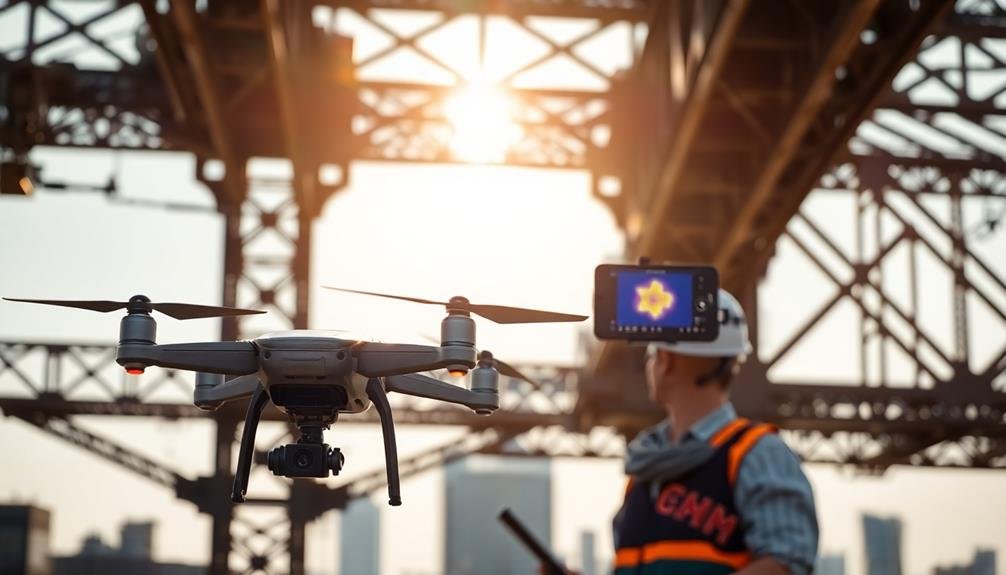
Structural integrity assessment is another key area where drones are revolutionizing industrial asset management. You can now inspect hard-to-reach areas of large structures like bridges, towers, and pipelines with ease and safety. Drones equipped with high-resolution cameras and sensors can capture detailed images and data, allowing you to detect cracks, corrosion, or other structural defects that might be invisible to the naked eye.
These aerial inspections offer significant advantages over traditional methods:
- Reduced risk to human inspectors
- Increased frequency of inspections
- More thorough coverage of the structure
- Cost-effective compared to manual inspections
You'll find that drone-based structural assessments are particularly valuable for aging infrastructure. By regularly monitoring critical assets, you can identify potential issues early, prioritize maintenance tasks, and prevent costly failures.
The data collected by drones can be analyzed using AI and machine learning algorithms, providing you with actionable insights and predictive maintenance recommendations. This proactive approach to asset management helps you extend the lifespan of your infrastructure, improve safety, and optimize your maintenance budget.
Data Processing and Analysis
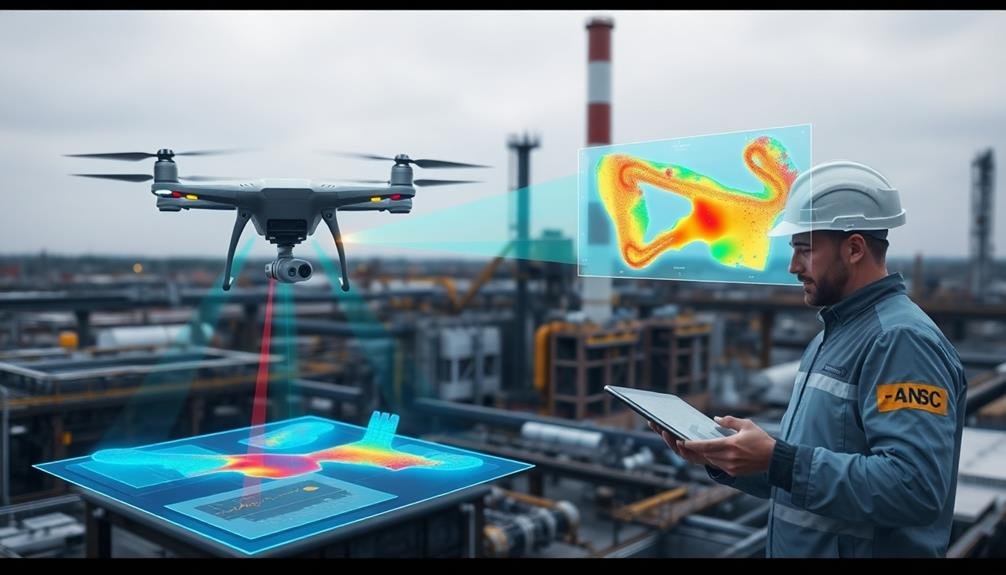
Once you've collected data using drones, the next essential step is processing and analyzing it effectively. Advanced software solutions are vital for this task, as they can handle large volumes of data quickly and accurately.
You'll need to use specialized algorithms to process images, videos, and sensor readings, converting raw data into actionable insights. Machine learning and artificial intelligence play a significant role in this process. These technologies can identify patterns, detect anomalies, and predict potential issues before they become critical.
You'll find that automated reporting tools can generate thorough assessments of asset conditions, saving time and reducing human error.
3D modeling software is another essential component. It allows you to create detailed digital twins of your industrial assets, enabling virtual inspections and simulations. You'll be able to compare current conditions with historical data, tracking changes over time and identifying trends.
Data visualization tools are vital for presenting complex information in an easily understandable format. You'll use these to create interactive dashboards, charts, and graphs that help stakeholders make informed decisions quickly.
Cost-Effective Maintenance Strategies
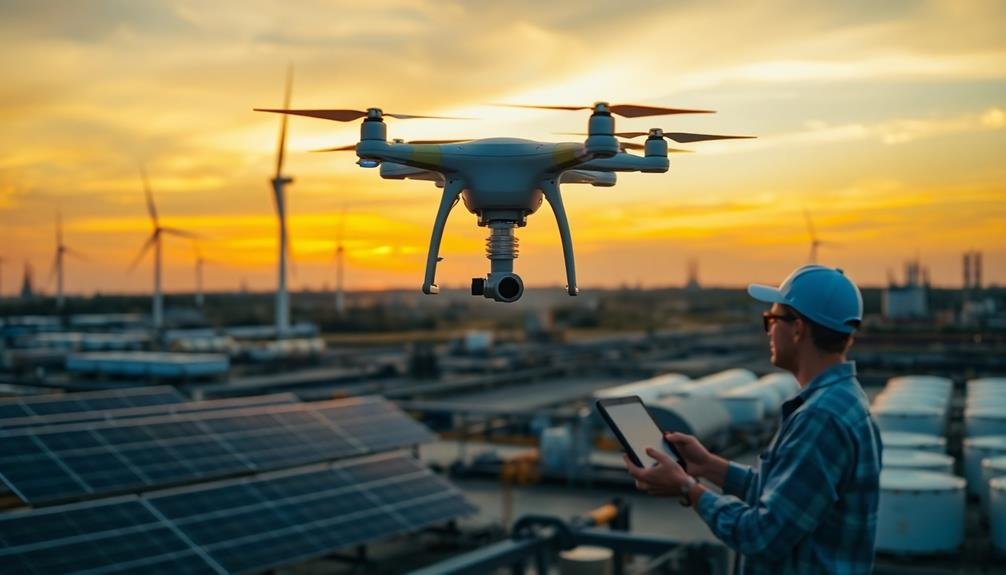
Implementing cost-effective maintenance strategies is essential for maximizing the benefits of drone-based asset management. By utilizing drones for inspections and data collection, you'll greatly reduce the need for manual labor and equipment rentals. This approach allows you to allocate resources more efficiently, focusing on preventive maintenance rather than costly reactive repairs.
To optimize your maintenance strategies using drone solutions, consider the following:
- Prioritize assets based on criticality and condition
- Establish a regular inspection schedule using drones
- Implement predictive maintenance using AI-powered analytics
- Develop a rapid response plan for addressing urgent issues
By adopting these strategies, you'll minimize downtime and extend the lifespan of your industrial assets. Drones enable you to detect potential problems early, allowing for timely interventions that prevent costly breakdowns.
You'll also improve safety by reducing the need for workers to access hazardous areas.
Moreover, drone-based maintenance strategies help you comply with regulatory requirements more efficiently. You'll have thorough documentation of asset conditions and maintenance activities, streamlining audits and reporting processes.
This approach not only saves time and money but also enhances your organization's reputation for reliability and safety.
Safety Enhancement Through Drones
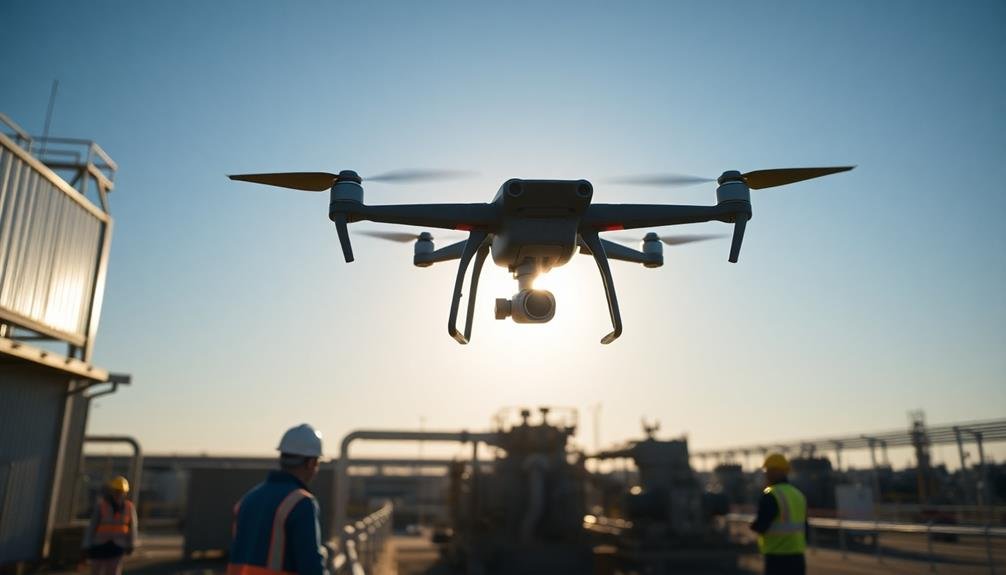
In addition to cost savings, drones greatly enhance safety in industrial asset management. You'll find that these unmanned aerial vehicles can access hazardous or hard-to-reach areas, reducing the need for workers to put themselves at risk.
Drones can inspect tall structures, confined spaces, and dangerous environments without exposing personnel to potential falls, toxic substances, or other workplace hazards.
You can use drones equipped with high-resolution cameras and sensors to perform thorough inspections of industrial assets like power lines, oil rigs, and chemical storage tanks. This allows you to detect potential safety issues before they become critical, preventing accidents and minimizing downtime.
Thermal imaging cameras on drones can identify hot spots in electrical systems or detect gas leaks, alerting you to problems that might otherwise go unnoticed.
During emergency situations, drones provide real-time aerial views, helping you coordinate response efforts more effectively. You can use them to assess damage, locate personnel, and guide rescue operations.
Real-Time Monitoring Capabilities
Drones' real-time monitoring capabilities revolutionize industrial asset management. You'll find these unmanned aerial vehicles equipped with high-resolution cameras, thermal sensors, and other advanced technologies that provide instant data on your assets' condition.
This real-time information allows you to make quick, informed decisions and respond promptly to any issues that arise.
With drone-based real-time monitoring, you can:
- Detect anomalies or potential problems before they escalate
- Track the progress of ongoing operations or maintenance activities
- Assess the impact of environmental factors on your assets
- Monitor remote or hard-to-reach locations with ease
Asset Lifecycle Management
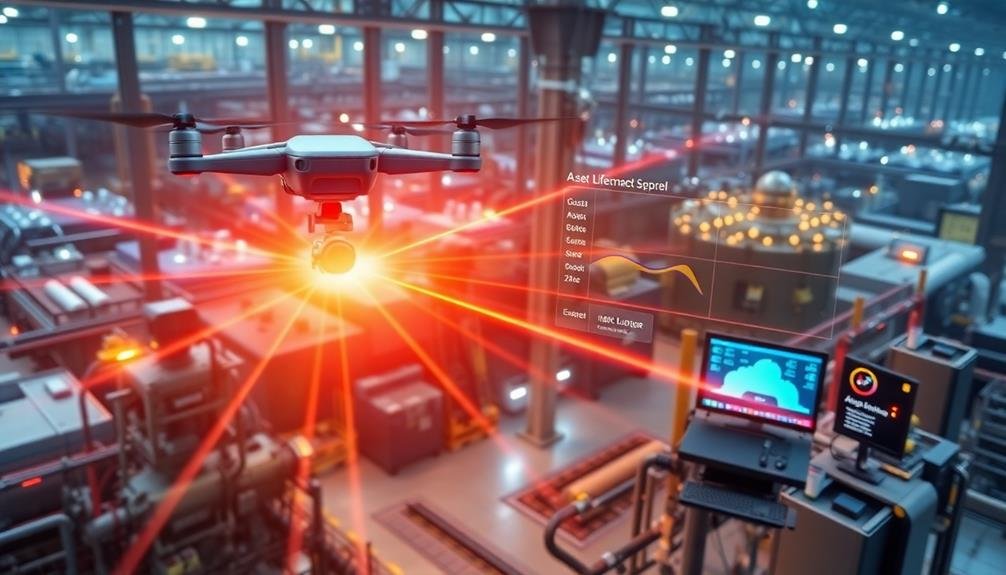
You'll find drones invaluable throughout your industrial assets' lifecycle.
They're essential for regular inspection and condition assessment, enabling you to spot issues early and plan predictive maintenance effectively.
When assets reach the end of their useful life, drones can assist in the decommissioning and disposal process, ensuring safety and efficiency.
Inspection and Condition Assessment
Precision and efficiency are at the forefront of industrial asset inspection and condition assessment. Drones have revolutionized this process, allowing you to gather detailed data quickly and safely.
You'll find that these aerial tools can access hard-to-reach areas, reducing the need for scaffolding or rope access. They're equipped with high-resolution cameras and sensors that capture visual and thermal imagery, helping you identify potential issues before they escalate.
When conducting drone-based inspections, you'll benefit from:
- Real-time data collection and analysis
- Reduced downtime and operational disruptions
- Enhanced safety for inspection personnel
- Consistent and repeatable results for trend analysis
Predictive Maintenance Planning
Taking asset management to the next level, predictive maintenance planning leverages drone-collected data to optimize your equipment's lifecycle.
By analyzing high-resolution imagery and sensor data gathered during routine drone inspections, you can identify potential issues before they escalate into costly breakdowns.
You'll be able to schedule maintenance activities more efficiently, focusing on assets that truly need attention. This approach reduces unnecessary downtime and extends the lifespan of your equipment.
Drones equipped with thermal cameras can detect overheating components, while multispectral sensors can identify early signs of corrosion or structural weaknesses.
Machine learning algorithms process this data, recognizing patterns and anomalies that might escape human observation.
They'll provide you with actionable insights, helping you prioritize maintenance tasks and allocate resources effectively.
You can create detailed maintenance schedules based on actual asset conditions rather than arbitrary time intervals.
Decommissioning and Disposal
At the end of an asset's lifecycle, drones play an essential role in decommissioning and disposal processes. They provide valuable insights and support for safe, efficient, and environmentally responsible asset retirement.
You'll find drones particularly useful for evaluating hazardous or hard-to-reach areas, reducing human risk exposure during the decommissioning phase. Drones equipped with high-resolution cameras and sensors can create detailed 3D models of facilities, helping you plan dismantling procedures and identify potential environmental hazards.
They're also invaluable for monitoring the progress of decommissioning activities, guaranteeing compliance with regulations, and documenting the site's condition before, during, and after the process.
Here's how drones can assist in decommissioning and disposal:
- Conduct thorough site inspections to identify hazardous materials
- Create accurate 3D models for planning and documentation
- Monitor dismantling progress and guarantee safety protocols are followed
- Evaluate environmental impact and verify site restoration
Regulatory Compliance Assistance
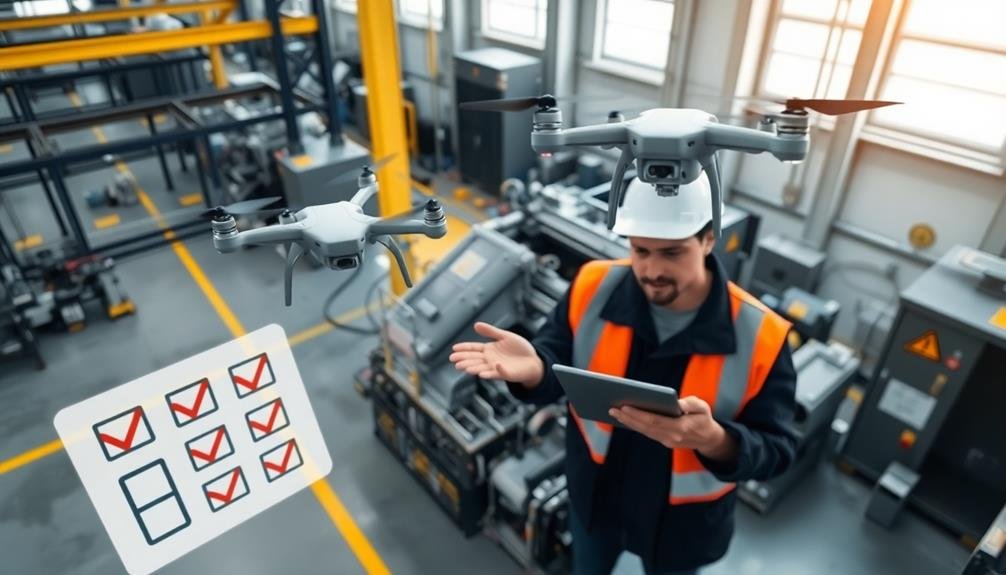
Drones can greatly enhance your regulatory compliance efforts by efficiently collecting essential data.
You'll streamline inspection processes, reducing time and labor costs while improving accuracy.
Data Collection for Compliance
Regulatory compliance in industrial settings can be a complex and time-consuming process. Drones can greatly streamline data collection for compliance purposes, offering a more efficient and accurate way to gather information.
You'll find that using drones for compliance-related data collection can save time, reduce costs, and improve safety for your staff.
Drones equipped with high-resolution cameras and specialized sensors can capture detailed imagery and data about your industrial assets. This information can be used to demonstrate compliance with various regulations, including environmental, safety, and operational standards.
You can use drone-collected data to:
- Document the condition of equipment and infrastructure
- Monitor emissions and detect potential leaks
- Assess workplace safety conditions
- Track changes in land use or environmental impact
Streamlining Inspection Processes
Beyond data collection, drones play a key role in streamlining inspection processes for regulatory compliance.
You'll find that these aerial devices can greatly reduce the time and resources required for inspections while enhancing safety and accuracy.
By using drones, you can access hard-to-reach areas of industrial assets without scaffolding or putting workers at risk.
They can capture high-resolution images and videos of structures, equipment, and facilities, allowing for detailed remote inspections.
This means you'll detect potential issues earlier and more efficiently.
Drones equipped with thermal cameras and other specialized sensors can identify problems invisible to the naked eye, such as gas leaks or structural weaknesses.
You'll also benefit from automated flight paths and AI-powered image analysis, which guarantee consistent, repeatable inspections and help identify trends over time.
Environmental Impact Reduction
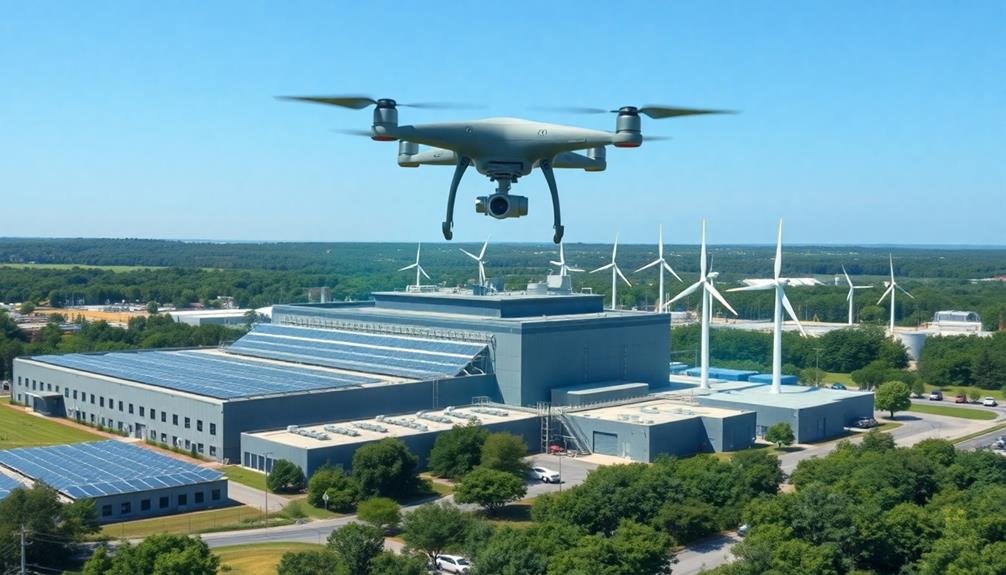
Through the lens of sustainability, industrial asset management is undergoing a green revolution with the adoption of drone technology. You'll find that drones considerably reduce the environmental impact of traditional inspection methods. By replacing ground vehicles and manned aircraft, drones cut down on fuel consumption and emissions.
They're also less intrusive, minimizing disturbances to local ecosystems and wildlife.
You can expect several environmental benefits when implementing drone solutions:
- Reduced carbon footprint due to lower fuel consumption
- Decreased noise pollution in sensitive areas
- Minimized physical impact on landscapes and habitats
- Enhanced ability to monitor and protect environmentally critical zones
Drones enable you to conduct more frequent inspections without increasing your environmental impact. This allows for better maintenance scheduling and early detection of potential issues, preventing larger environmental incidents.
You'll also find that drones can access hard-to-reach areas more easily, reducing the need for invasive infrastructure like temporary roads or scaffolding.
Future Trends in Drone Technology

As we look ahead, drone technology for industrial asset management is poised for remarkable advancements.
You'll see drones with longer flight times and increased payload capacity, allowing for more extensive inspections and data collection. AI and machine learning integration will enhance autonomous navigation and decision-making capabilities, reducing the need for human intervention.
Expect improvements in sensor technology, including higher-resolution cameras, thermal imaging, and LiDAR systems. These advancements will provide more detailed and accurate asset data, enabling better predictive maintenance and risk assessment.
Swarm technology will allow multiple drones to work together seamlessly, covering larger areas and completing tasks more efficiently.
You'll also witness the development of hybrid drones that can shift between aerial and ground-based operations, expanding their versatility in industrial settings.
5G connectivity will enable real-time data transmission and processing, facilitating instant analysis and decision-making.
Additionally, you'll see progress in drone charging and docking stations, allowing for continuous operation without manual battery swaps.
As regulations evolve, you can anticipate expanded beyond visual line of sight (BVLOS) operations, opening up new possibilities for remote asset management and monitoring in industrial environments.
Frequently Asked Questions
How Long Does It Take to Train a Drone Operator?
You'll need about 15-40 hours of training to become a proficient drone operator. This includes learning regulations, flight techniques, and safety protocols. Your training duration may vary depending on your skill level and the specific drone model.
What Insurance Considerations Are There for Industrial Drone Operations?
You'll need liability coverage for potential damage or injuries. Consider hull insurance for your drones, and cyber insurance for data breaches. Don't forget to check if your existing policies cover drone operations or if you need specialized coverage.
Can Drones Be Used Effectively in Harsh Weather Conditions?
You can use drones in harsh weather, but there are limitations. Many models withstand wind and light rain. Specialized drones handle extreme cold or heat. Always check manufacturer specs and local regulations before flying in challenging conditions.
How Do Companies Integrate Drone Data With Existing Asset Management Systems?
You'll integrate drone data into existing asset management systems through APIs, cloud platforms, and specialized software. You can automate data transfer, sync information with your databases, and create custom dashboards to visualize and analyze the collected data effectively.
What Are the Battery Life Limitations for Industrial Drones?
You'll find industrial drones typically have battery lives of 20-30 minutes. However, newer models can last up to an hour. You're limited by payload weight and weather conditions, so plan flights accordingly for peak performance.
In Summary
You've seen how drones are revolutionizing industrial asset management. They're not just tools; they're game-changers. From aerial inspections to data analysis, they're making your job easier and safer. As drone technology advances, you'll find even more ways to streamline operations, cut costs, and boost efficiency. Embrace these solutions, and you'll stay ahead of the curve. The future of asset management is in the sky – don't let it fly by you.

As educators and advocates for responsible drone use, we’re committed to sharing our knowledge and expertise with aspiring aerial photographers.
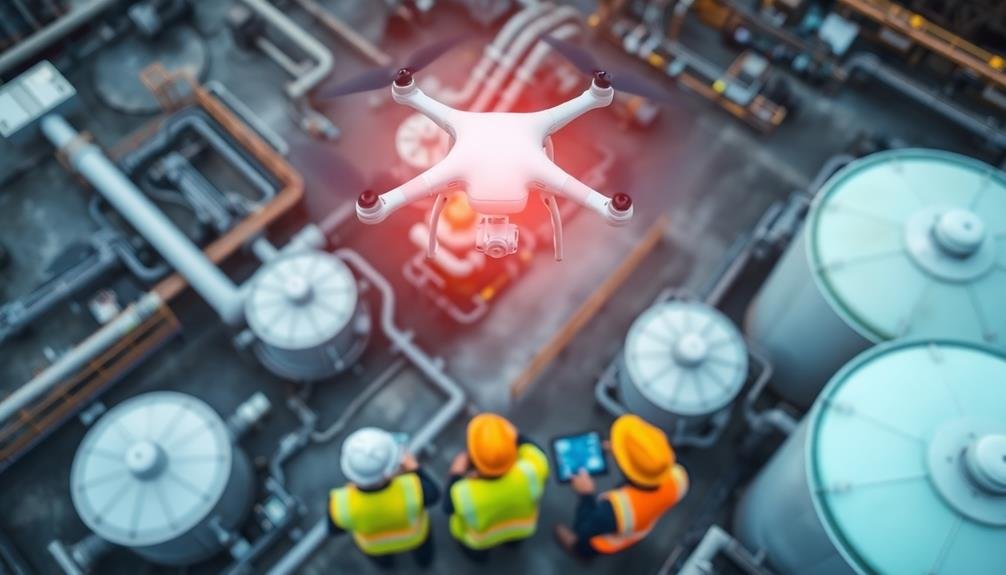



Leave a Reply